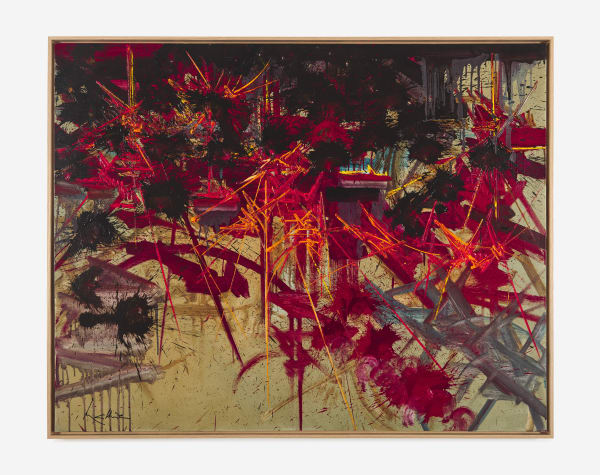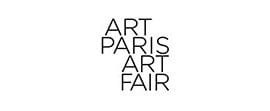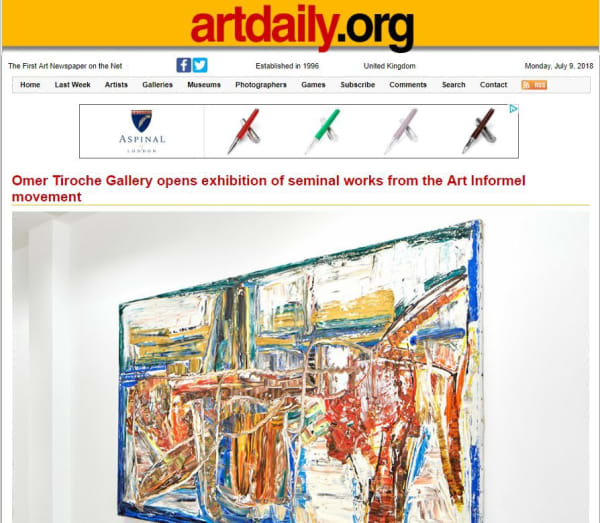Georges Mathieu French, 1921-2012
Georges Mathieu was born in Boulogne-sur-Mer, France in 1921 and is celebrated for his influential contributions to Post-War Abstraction, both through his own paintings and his championing of avant-garde movements such as Lyrical Abstraction.
Mathieu was largely self-taught, having received no academic training, yet his work epitomised the radical changes in art at that time. Mathieu first exhibited in 1946 in the exhibition Salon des moins de 30 ans at Galerie des Beaux-Arts Paris. The following year he had moved to Paris and founded the group L’Imaginaire, with Wols, Riopelle and Hartung, amongst others. Throughout this time, Mathieu also published numerous manifestos that outlined the foundations of Lyrical Abstraction. Key characteristics of the movement were speed of execution, the exclusion of pre-existing shapes and forms, and spontaneity; all of these elements are synonymous with his work and can be seen in his compositions bursting with calligraphic lines darting from one edge of the canvas to the other. Mathieu often squeezed paint directly from the tube onto his canvases, emphasising the importance of rapid spontaneous expression.
In 1951 Mathieu played an instrumental role in facilitating the exposure of American and European Abstraction. Together with renowned art critic Michel Tapié, they curated the infamous exhibition Véhémences confrontées at Galerie Nina Dausset, featuring Pollock, de Kooning, Hartung and Riopelle.
As early as 1963 Mathieu had his first major retrospective at the Musée National d´Art Moderne in Paris, and he continued to have both commercial and critical success up until his death. His works can be found in collections worldwide, including at the Centre Pompidou in Paris, Mumok in Vienna, the Museu de Arte Moderna, Rio de Janeiro, and the Kunsthalle Basel in Switzerland
Mathieu died in Boulogne-Billancourt in 2012.
-

Intercontinental Abstraction
11 Oct - 22 Dec 2023 LondonExplore the legacy of abstraction at Omer Tiroche Gallery's Intercontinental Abstraction exhibition. Discover artworks spanning 75 years and 5 continents, featuring renowned artists like Abdoulaye Konaté, Georges Mathieu, Joan Mitchell, and Zao Wou-Ki. Experience the evolution from traditional art to abstraction, driven by societal shifts and artistic freedom. Lyrical Abstraction founder Georges Mathieu's bold response to WWII, Jean Arp's three-dimensional marvels, and the cross-cultural influences in Zao Wou-Ki's work showcase the global impact of abstraction. Immerse yourself in a universal language that captures the complexities of the modern era, leaving a lasting creative legacy. Featured artists: Jean Arp, Anthony Caro, Lucio Fontana, and more.Read more -

Everything Must Go!
23 May - 26 Aug 2022 LondonOmer Tiroche Gallery is pleased to present a summer group show, Everything Must Go!, featuring works by Jean-Michel Basquiat, Alexander Calder, David Hockney, Georges Mathieu, and Victor Vasarely among other...Read more -

Un Art Autre
26 Jun - 31 Aug 2018 LondonOmer Tiroche Gallery is pleased to announce the forthcoming exhibition of Un Art Autre , featuring seminal works by artists who were instrumental in forming the radical avant-garde movement that...Read more






